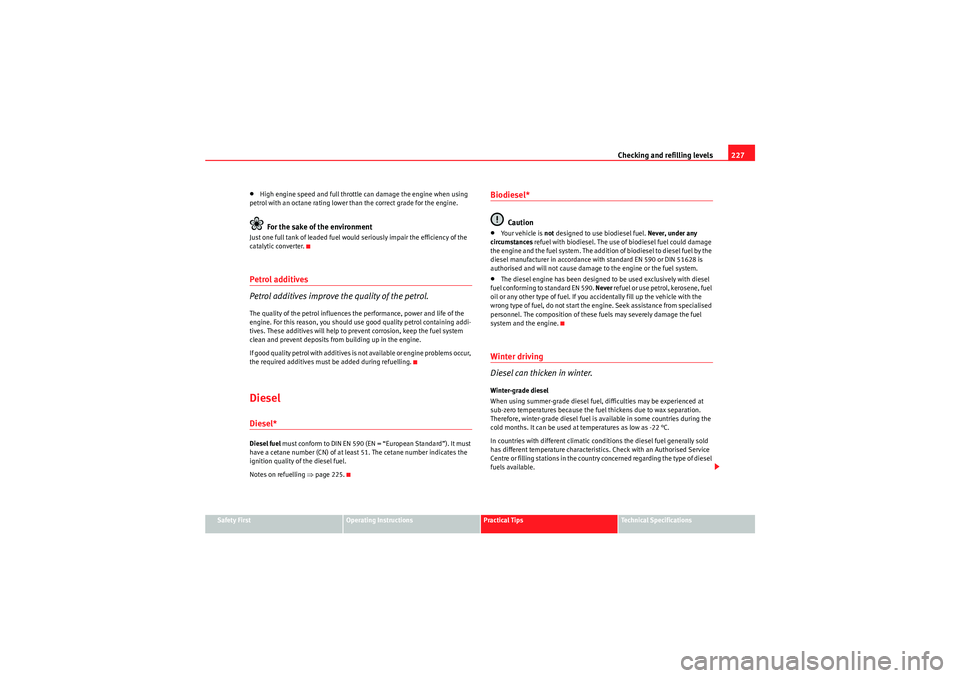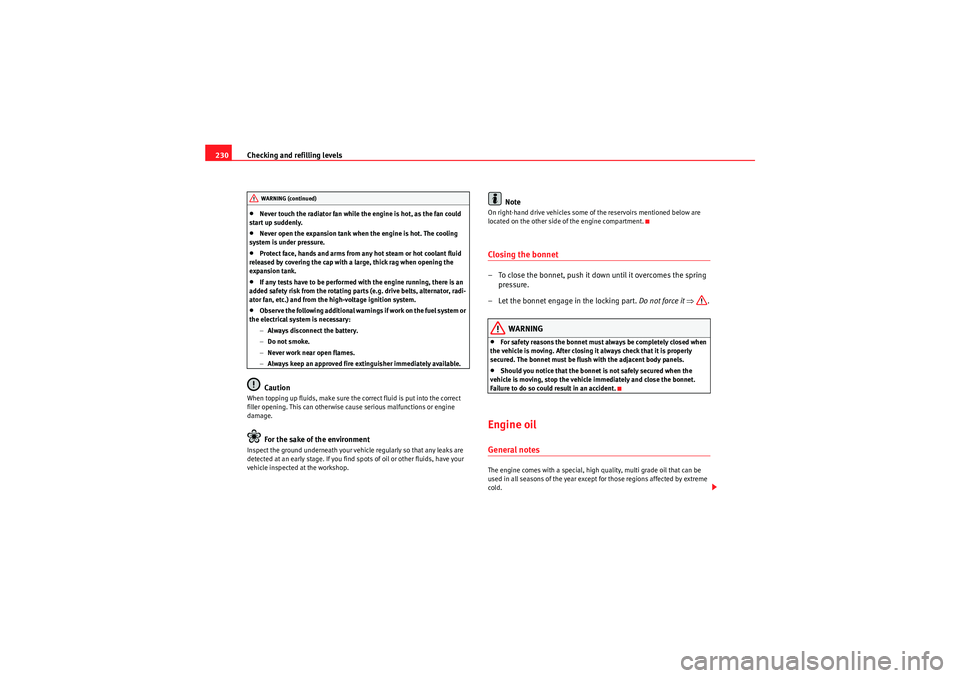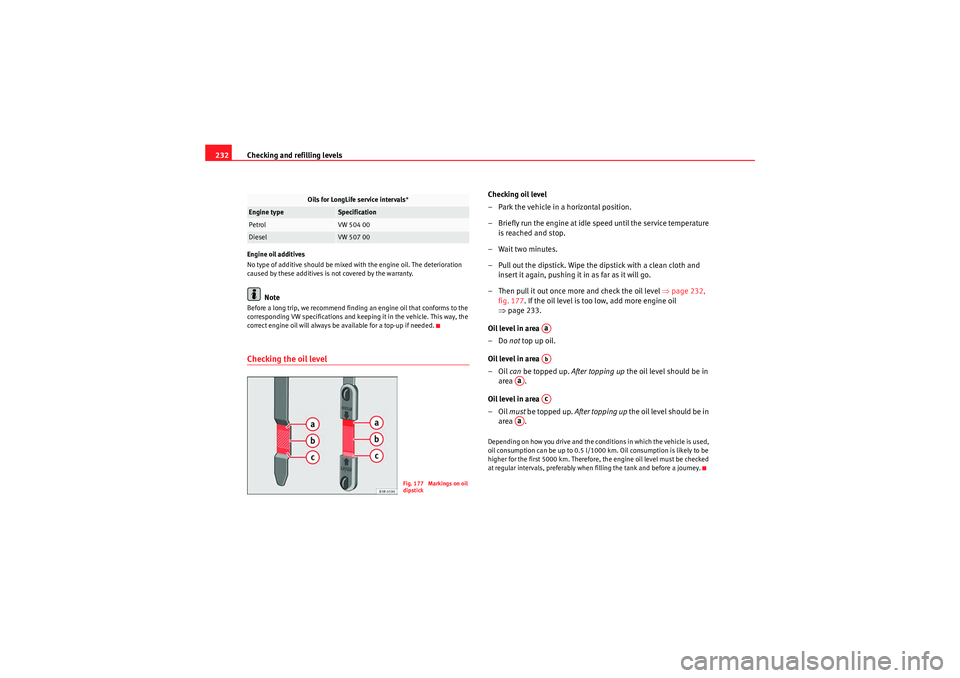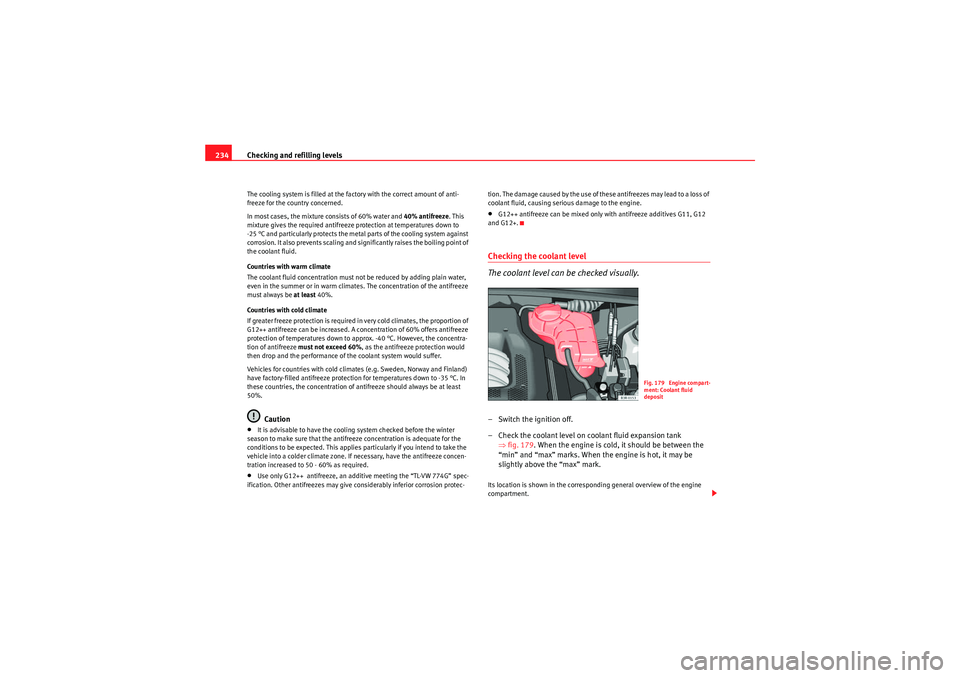engine Seat Exeo ST 2010 Repair Manual
[x] Cancel search | Manufacturer: SEAT, Model Year: 2010, Model line: Exeo ST, Model: Seat Exeo ST 2010Pages: 325, PDF Size: 9.34 MB
Page 228 of 325

Checking and refilling levels
226
− For safety reasons we do not recommend carrying a spare fuel
canister in the vehicle. The canister could be damaged in an accident
and leak.•If, in exceptional circumstances, you have to carry a spare fuel canister,
please observe the following points:
−Never fill the spare fuel canister inside the vehicle or on it. An elec-
trostatic charge could build up during filling, causing the fuel fumes to
ignite. This could cause an explosion. Always place the canister on the
ground to fill it.
− Insert the fuel nozzle into the mouth of the canister as far as
possible.
− If the spare fuel canister is made of metal, the filling nozzle must be
in contact with the canister during filling. This helps prevent an electro-
static charge building up.
− Never spill fuel in the vehicle or in the luggage compartment. Fuel
vapours are explosive. Danger of death.Caution
•Fuel spills should be removed from the paintwork immediately.•Never run the tank completely dry. An irregular fuel supply could cause
misfiring. As a result, unburnt fuel could enter the catalytic converter and
cause damage.•When filling the fuel tank after having run it completely dry on a vehicle
with a diesel engine the ignition must be switched on for at least 30 seconds
without starting the engine. When you then start the engine it may take
longer than normal (up to one minute) for the engine to start firing. This is due
to the fact that the fuel system has to purge itself of air before starting.
For the sake of the environment
Do not try to put in more fuel after the automatic filler nozzle has switched off;
this may cause the fuel to overflow if it becomes warm.PetrolPetrol types
The recommended fuel types are listed on a sticker inside the
fuel tank flap.Only unleaded petrol conforming to standard DIN EN 228 may be used for
vehicles with catalytic converters (EN = “European Standard”).
Fuel types are differentiated by the octane rating, e.g: 91, 95, 98 RON (RON
= “Research Octane Number”, unit for determining the knock resistance of
petrol). You may use petrol with a higher octane number than the one recom-
mended for your engine. However, this has no advantage in terms of fuel
consumption and engine power.
The correct fuel type for your vehicle is given in the technical table for the
engine, in the Technical Specifications section.
Caution
•Petrol with standard EN 228 may be mixed with small quantities of
ethanol. However, the bioethanol fuels available at commercial establish-
ments with reference E50 or E85, which contain a high percentage of ethanol,
may not be used, as they will damage the fuel system.•Even one tankful of leaded fuel would permanently impair the efficiency
of the catalytic converter.
WARNING (continued)
ExeoST_EN.book Seite 226 Freitag, 3. September 2010 11:41 11
Page 229 of 325

Checking and refilling levels227
Safety First
Operating Instructions
Practical Tips
Technical Specifications
•High engine speed and full throttle can damage the engine when using
petrol with an octane rating lower than the correct grade for the engine.For the sake of the environment
Just one full tank of leaded fuel would seriously impair the efficiency of the
catalytic converter.Petrol additives
Petrol additives improve the quality of the petrol.The quality of the petrol influences the performance, power and life of the
engine. For this reason, you should use good quality petrol containing addi-
tives. These additives will help to prevent corrosion, keep the fuel system
clean and prevent deposits from building up in the engine.
If good quality petrol with additives is not available or engine problems occur,
the required additives must be added during refuelling.DieselDiesel*Diesel fuel must conform to DIN EN 590 (EN = “European Standard”). It must
have a cetane number (CN) of at least 51. The cetane number indicates the
ignition quality of the diesel fuel.
Notes on refuelling ⇒ page 225.
Biodiesel*
Caution
•Your vehicle is not designed to use biodiesel fuel. Never, under any
circumstances refuel with biodiesel. The use of biodiesel fuel could damage
the engine and the fuel system. The addition of biodiesel to diesel fuel by the
diesel manufacturer in accordance with standard EN 590 or DIN 51628 is
authorised and will not cause damage to the engine or the fuel system.•The diesel engine has been designed to be used exclusively with diesel
fuel conforming to standard EN 590. Never refuel or use petrol, kerosene, fuel
oil or any other type of fuel. If you accidentally fill up the vehicle with the
wrong type of fuel, do not start the engine. Seek assistance from specialised
personnel. The composition of these fuels may severely damage the fuel
system and the engine.Winter driving
Diesel can thicken in winter.Winter-grade diesel
When using summer-grade diesel fuel, difficulties may be experienced at
sub-zero temperatures because the fuel thickens due to wax separation.
Therefore, winter-grade diesel fuel is available in some countries during the
cold months. It can be used at temperatures as low as -22 °C.
In countries with different climatic conditions the diesel fuel generally sold
has different temperature characteristics. Check with an Authorised Service
Centre or filling stations in the country concerned regarding the type of diesel
fuels available.
ExeoST_EN.book Seite 227 Freitag, 3. September 2010 11:41 11
Page 230 of 325

Checking and refilling levels
228Filter pre-heater
Your vehicle is fitted with a fuel filter glow plug system, making it well
equipped for operation in winter. This ensures that the fuel system remains
operational to approx. -24 °C, provided you use winter-grade diesel which is
safe to -15 °C.
However, if the fuel has waxed to such an extent that the engine will not start
at temperatures of under -24 °C, simply place the vehicle in a warm place for
a while.
Caution
Do not mix fuel additives (thinners or similar products) with diesel fuel.
BonnetReleasing the bonnet
The bonnet is released from inside the vehicle.– To release the bonnet, pull the lever under the dash panel
⇒fig. 175 in the direction indicated (arrow).The bonnet springs out of its lock.
Fig. 175 Detail of foot-
well area on driver side:
lever for unlocking the
bonnet.
ExeoST_EN.book Seite 228 Freitag, 3. September 2010 11:41 11
Page 231 of 325

Checking and refilling levels229
Safety First
Operating Instructions
Practical Tips
Technical Specifications
Opening the bonnetBefore opening the bonnet make sure that the windscreen wiper
arms are not lifted away from the glass. Otherwise the paint may be
damaged.
– Lift the bonnet slightly ⇒.
– Press the release catch under the bonnet upwards ⇒fig. 176 .
This will release the arrester hook under the bonnet.
– Open the bonnet.The bonnet is held in position by a gas-filled strut.
WARNING
Never open the bonnet if you see steam or drips of coolant being released
from the engine compartment. Failure to comply could result in burns. Wait
until no steam or coolant can be seen before opening the bonnet.Work in the engine compartment
Extra caution is necessary when working on components in
the engine compartment.Always be aware of the danger of injury and scalding as well as the risk of
accident or even fire when working in the engine compartment (e.g. when
checking and refilling fluids). Always observe the warnings listed below and
follow all general safety precautions. The engine compartment of the vehicle
is a potentially hazardous area ⇒
WARNING
•Switch the engine off.•Remove the ignition key.•Apply the handbrake firmly.•If your vehicle is equipped with a manual gearbox, place the gear lever
in neutral. If you are driving an automatic vehicle, place the selector lever
in position P.•Wait for the engine to cool down.•Children should not be allowed to approach the engine compartment.•Never spill liquids used for vehicle operation on the engine compart-
ment, as these may catch fire (e.g. coolant).•Take care not to cause short circuits in the electrical system, especially
when working on the battery.
Fig. 176 Release catch
under the bonnet
ExeoST_EN.book Seite 229 Freitag, 3. September 2010 11:41 11
Page 232 of 325

Checking and refilling levels
230•Never touch the radiator fan while the engine is hot, as the fan could
start up suddenly.•Never open the expansion tank when the engine is hot. The cooling
system is under pressure.•Protect face, hands and arms from any hot steam or hot coolant fluid
released by covering the cap with a large, thick rag when opening the
expansion tank.•If any tests have to be performed with the engine running, there is an
added safety risk from the rotating parts (e.g. drive belts, alternator, radi-
ator fan, etc.) and from the high-voltage ignition system.•Observe the following additional warnings if work on the fuel system or
the electrical system is necessary:
−Always disconnect the battery.
− Do not smoke.
− Never work near open flames.
− Always keep an approved fire extinguisher immediately available.Caution
When topping up fluids, make sure the correct fluid is put into the correct
filler opening. This can otherwise cause serious malfunctions or engine
damage.
For the sake of the environment
Inspect the ground underneath your vehicle regularly so that any leaks are
detected at an early stage. If you find spots of oil or other fluids, have your
vehicle inspected at the workshop.
Note
On right-hand drive vehicles some of the reservoirs mentioned below are
located on the other side of the engine compartment.Closing the bonnet– To close the bonnet, push it down until it overcomes the spring
pressure.
– Let the bonnet engage in the locking part. Do not force it ⇒ .
WARNING
•For safety reasons the bonnet must always be completely closed when
the vehicle is moving. After closing it always check that it is properly
secured. The bonnet must be flush with the adjacent body panels.•Should you notice that the bonnet is not safely secured when the
vehicle is moving, stop the vehicle immediately and close the bonnet.
Failure to do so could result in an accident.
Engine oilGeneral notesThe engine comes with a special, high quality, multi grade oil that can be
used in all seasons of the year except for those regions affected by extreme
cold.
WARNING (continued)
ExeoST_EN.book Seite 230 Freitag, 3. September 2010 11:41 11
Page 233 of 325

Checking and refilling levels231
Safety First
Operating Instructions
Practical Tips
Technical Specifications
As the use of good quality oil is necessary for the correct operation and long
service life of the engine, when it becomes necessary to replenish or change
the oil, always use an oil that complies to the VW standards.
The specifications (VW standards) set out in the following page should
appear on the container of the service oil; when the container displays the
specific standards for petrol and diesel engines together, it means that the
oil can be used for both types of engines.
We recommend that the oil change, indicated in the Maintenance
Programme, be performed by an Authorised Service Centre or a qualified
workshop.
The correct oil specifications for your engine are listed in
⇒page 231, “Oil
properties”.
Service intervals
Service intervals can be flexible (LongLife service) or fixed (dependent on
time/distance travelled).
If the PR code that appears on the back of the Maintenance Programme
booklet is QG1, this means that your vehicle has the LongLife service
programmed. If it has the codes QG0 or QG2 the interval service is dependent
on time/distance travelled.
Flexible service intervals (LongLife*)
Special oils and processes have been developed which, depending on the
characteristics and individual driving profiles, allow to extend the oil change
service (LongLife service intervals).
Because this oil is essential for extending the service intervals, it must only
be used observing the following indications:
•Avoid mixing it with oil for fixed service intervals.•Only in exceptional circumstances, if the engine oil level is too low
⇒ page 232 and LongLife oil is not available, it is permitted to top up (once)
with oil for fixed service intervals (up to a maximum of 0.5 litres). Fixed service intervals*
If your vehicle does not have the “LongLife service interval” or it has been
disabled (by request), you may use oils for
fixed service intervals, which also
appear in ⇒page 231, “Oil properties”. In this case, your vehicle must be
serviced after a fixed interval of 1 year / 15,000 km (whatever comes first)
⇒ Booklet “Maintenance Programme”.
•In exceptional circumstances, if the engine oil level is too low
⇒ page 232 and you cannot obtain the oil specified for your vehicle, you can
put in a small quantity of oil conforming to the specification ACEA A2 or
ACEA A3 (petrol engines) or ACEA B3 or ACEA B4 (diesel engines) (up to 0.5l).
Vehicles with diesel particulate filter*
All Exeo vehicles with a diesel engine have a diesel particulate filter and must
only be filled with VW 507 00 engine oil, which has a low level of soot forma-
tion. Using other types of oil will cause a higher soot concentration and
reduce the life of the DPF. Therefore:•Avoid mixing this oil with other engine oils.•Only in exceptional circumstances, if the engine oil level is too low
⇒ page 232 and you cannot obtain the oil specified for your vehicle, can you
put in a small quantity of oil (once) conforming to the VW 506 00, VW 506 01,
VW 505 00, VW 505 01 or ACEA B3 / ACEA B4 specification. (up to 0.5 l).Oil propertiesEngine type
Specification
Petrol
VW 502 00/ VW 504 00
Diesel. Engines with particu-
late filter (DPF)
a)
a)Only use recommended oils, otherwise you may damage the engine.
VW 507 00
ExeoST_EN.book Seite 231 Freitag, 3. September 2010 11:41 11
Page 234 of 325

Checking and refilling levels
232Engine oil additives
No type of additive should be mixed with the engine oil. The deterioration
caused by these additives is not covered by the warranty.
Note
Before a long trip, we recommend finding an engine oil that conforms to the
corresponding VW specifications and keeping it in the vehicle. This way, the
correct engine oil will always be available for a top-up if needed.Checking the oil level
Checking oil level
– Park the vehicle in a horizontal position.
– Briefly run the engine at idle speed until the service temperature
is reached and stop.
– Wait two minutes.
– Pull out the dipstick. Wipe the dipstick with a clean cloth and insert it again, pushing it in as far as it will go.
– Then pull it out once more and check the oil level ⇒page 232,
fig. 177 . If the oil level is too low, add more engine oil
⇒ page 233.
Oil level in area
–Do not top up oil.
Oil level in area
–Oil can be topped up. After topping up the oil level should be in
area .
Oil level in area
–Oil must be topped up. After topping up the oil level should be in
area .Depending on how you drive and the conditions in which the vehicle is used,
oil consumption can be up to 0.5 l/1000 km. Oil consumption is likely to be
higher for the first 5000 km. Therefore, the engine oil level must be checked
at regular intervals, preferably when filling the tank and before a journey.
Oils for LongLife service intervals *
Engine type
Specification
Petrol
VW 504 00
Diesel
VW 507 00
Fig. 177 Markings on oil
dipstick
AaAb
Aa
Ac
Aa
ExeoST_EN.book Seite 232 Freitag, 3. September 2010 11:41 11
Page 235 of 325

Checking and refilling levels233
Safety First
Operating Instructions
Practical Tips
Technical Specifications
Topping up the engine oil
�E
–Unscrew cap
�E
from oil filler opening ⇒page 301, fig. 248 .
– Carefully put in the specified grade of oil ⇒page 231, adding
0.5 litres at a time.
– After two minutes, check the oil level once again ⇒page 232.
– Where necessary, add more engine oil.
– Replace the oil filler cap carefully and push the dipstick all the way in.
WARNING
•When refilling with oil, make sure no oil falls onto hot engine parts.
Failure to comply could result in fire.•Wash your skin thoroughly if it comes into contact with engine oil.
Caution
•The oil level must never be above area . This could damage the cata-
lytic converter or the engine. Contact a qualified workshop to drain the engine
oil if necessary.•No additives should be used with engine oil. Any damage caused by the
use of such additives would not be covered by the factory warranty.For the sake of the environment
•Oil must not be disposed of in the drain or on the ground.•Always observe legal requirements when disposing of empty oil
canisters.Cooling systemCoolant fluid
The purpose of the coolant fluid is to carry heat away from the
engine. The correct amount of antifreeze is decisive in
preventing the cooling system from freezing in winter.The vehicle's engine cooling system is filled for life at the factory, so no
coolant needs to be changed. The coolant fluid consists of a mixture of water
and antifreeze G12++. This is a glycol-based antifreeze with anti-corrosion
additives.
Coolant fluid additive
The amount of antifreeze required depends on the temperatures to be
expected in the winter season. If the antifreeze concentration is too low the
coolant can freeze, resulting in failure of the cooling system and heater.
Fig. 178 In the engine
compartment: Engine oil
filler cap
Aa
ExeoST_EN.book Seite 233 Freitag, 3. September 2010 11:41 11
Page 236 of 325

Checking and refilling levels
234The cooling system is filled at the factory with the correct amount of anti-
freeze for the country concerned.
In most cases, the mixture consists of 60% water and 40% antifreeze . This
mixture gives the required antifreeze protection at temperatures down to
-25 °C and particularly protects the metal parts of the cooling system against
corrosion. It also prevents scaling and significantly raises the boiling point of
the coolant fluid.
Countries with warm climate
The coolant fluid concentration must not be reduced by adding plain water,
even in the summer or in warm climates. The concentration of the antifreeze
must always be at least 40%.
Countries with cold climate
If greater freeze protection is required in very cold climates, the proportion of
G12++ antifreeze can be increased. A concentration of 60% offers antifreeze
protection of temperatures down to approx. -40 °C. However, the concentra-
tion of antifreeze must not exceed 60% , as the antifreeze protection would
then drop and the performance of the coolant system would suffer.
Vehicles for countries with cold climates (e.g. Sweden, Norway and Finland)
have factory-filled antifreeze protection for temperatures down to -35 °C. In
these countries, the concentration of antifreeze should always be at least
50%.
Caution
•It is advisable to have the cooling system checked before the winter
season to make sure that the antifreeze concentration is adequate for the
conditions to be expected. This applies particularly if you intend to take the
vehicle into a colder climate zone. If necessary, have the antifreeze concen-
tration increased to 50 - 60% as required.•Use only G12++ antifreeze, an additive meeting the “TL-VW 774G” spec-
ification. Other antifreezes may give considerably inferior corrosion protec- tion. The damage caused by the use of these antifreezes may lead to a loss of
coolant fluid, causing serious damage to the engine.
•G12++ antifreeze can be mixed only with antifreeze additives G11, G12
and G12+.Checking the coolant level
The coolant level can be checked visually.– Switch the ignition off.
– Check the coolant level on coolant fluid expansion tank ⇒fig. 179 . When the engine is cold, it should be between the
“min” and “max” marks. When the engine is hot, it may be
slightly above the “max” mark.Its location is shown in the corresponding general overview of the engine
compartment.
Fig. 179 Engine compart-
ment: Coolant fluid
deposit
ExeoST_EN.book Seite 234 Freitag, 3. September 2010 11:41 11
Page 237 of 325

Checking and refilling levels235
Safety First
Operating Instructions
Practical Tips
Technical Specifications
The coolant level should be checked with the engine switched off.
The coolant level is monitored by a warning lamp on the instrument panel
display
⇒page 78. However, we recommend that it should be checked occa-
sionally.
Coolant fluid loss
Any loss of coolant fluid normally indicates a leak in the cooling system. In
this case the cooling system should be inspected by a qualified workshop
without delay. It is not sufficient merely to top up the coolant fluid.
If there are no leaks in the system, a loss of coolant fluid can only occur if the
coolant boils and is forced out of the system as a result of overheating.
Caution
Radiator sealants must not be added to the coolant fluid. Such additives
could seriously impair the function of the cooling system.Topping up the coolant fluid
Be careful when topping up with coolant fluid.– Switch the engine off.
– Wait for the engine to cool down.
– Cover the cap on the expansion tank ⇒fig. 179 with a cloth, and
carefully unscrew the cap anti-clockwise ⇒.
– Add coolant fluid.
– Screw on the cap tightly.
Make sure that the coolant fluid meets the required specifications
⇒page 233, “Coolant fluid”. Do not use a different type of antifreeze if
G12++ antifreeze is not available. In this case, use only water and bring the
antifreeze concentration back up to the correct level as soon as possible.
Always top up with new coolant fluid.
Do not fill above the “max” mark. Excess coolant fluid is forced out of the
system through the valve in the filler cap when the engine gets hot.
If a lot of coolant fluid has been lost, wait for the engine to cool down before
putting in cold coolant. Failure to do so could result in serious engine
damage.
WARNING
•The cooling system is under pressure. Do not unscrew the cap on the
expansion tank when the engine is hot. Failure to comply could result in
burns.•The antifreeze and coolant fluid can be a health hazard. Therefore, the
antifreeze should be stored in the original container in a safe place out of
reach of children. Failure to comply could result in poisoning.For the sake of the environment
Drained off coolant should not be used again. Drain off the used coolant into
a suitable container and dispose of it in the proper manner (observe environ-
mental regulations).
ExeoST_EN.book Seite 235 Freitag, 3. September 2010 11:41 11